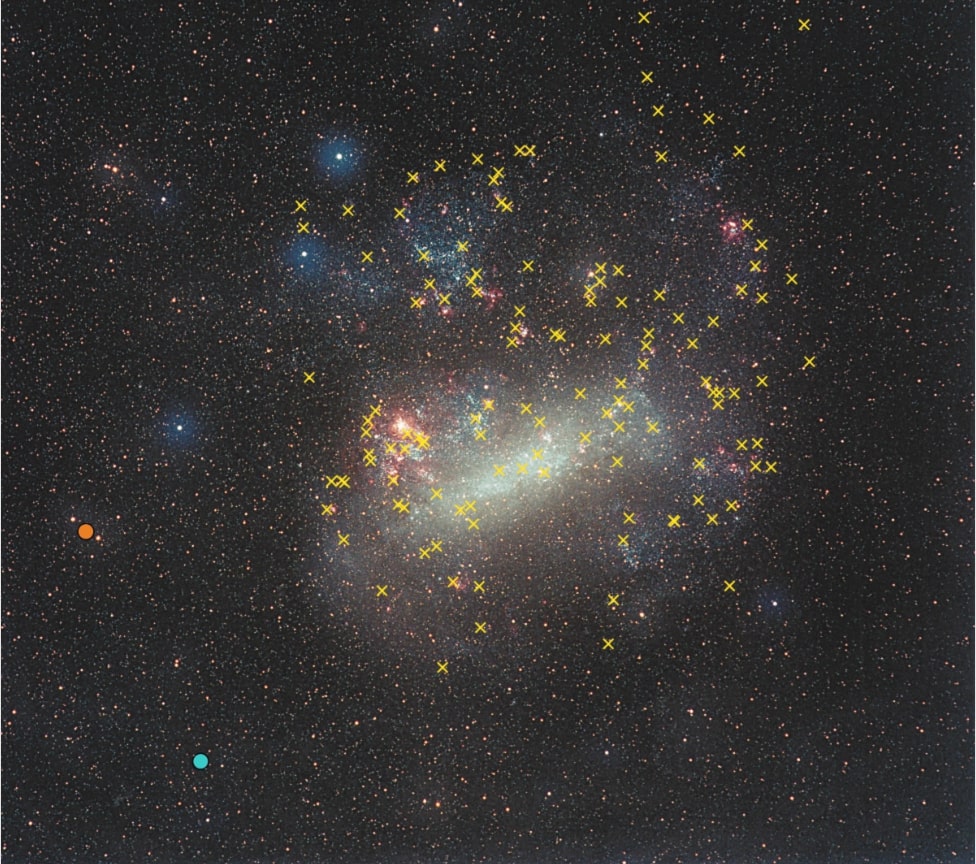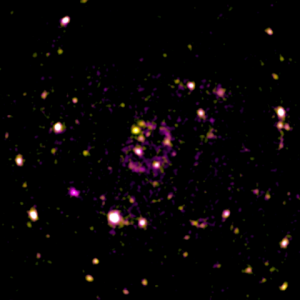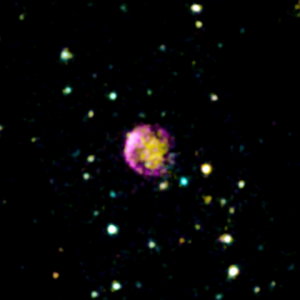Remeis Researchers have discovered the leftovers of two stellar explosions in the outskirts of our neighbor galaxy, using ESA’s XMM-Newton satellite.

Visible-light image of the Large Magellanic Cloud, showcasing the distribution of stars in our neighbor galaxy, which are concentrated in a white bar-like structure. The two objects that XMM-Newton looked at are shown as the two circles in the lower left: J0624-6948 (orange, higher in the image) and J0614-7251 (blue, lower in the image). The yellow crosses represent the population of supernova remnants in the galaxy that were previously known. Credit: ESA; Eckhard Slawik
When the European Space Agency’s XMM-Newton pointed its telescope at two unidentified sources of light in the outskirts of the Large Magellanic Cloud, scientists from the Remeis Observatory were able to confirm what seemed an unlikely discovery. The team led by Prof. Manami Sasaki, head of the multiwavelength group at Remeis, found two supernova remnants in the far reaches of our neighboring galaxy.

XMM-Newton’s X-ray view of J0624-6948. A weak-purple appearing ring corresponds to the signature of the explosion’s blast-wave heating the surrounding medium. Credit: ESA/XMM-Newton; Manami Sasaki, Federico Zangrandi
It is surprising that these two sources of light, which astronomers have named J0624-6948 and J0614-7251, turned out to be supernova remnants, leftovers of exploded stars, far away from all other such objects that the science community knew of before. Scientists believe, that for the shock of a supernova to leave such an imprint on its surroundings, the dying star must be in an environment that is sufficiently dense, which is not usually found so far in the outer reaches of a galaxy. This is one of the new things the community can learn from the discovery enabled by XMM-Newton: The environment around the Large Magellanic Cloud is made up of denser gas than expected. The reason for this likely lies in how the galaxy is interacting with the Milky Way and its “sibling”, the Small Magellanic Cloud.

X-ray image of supernova remnant J0614-7251, captured by XMM-Newton. A purple ring from the shock wave and a yellow glow from iron produced during the explosion are clearly visible, apart from several unrelated background sources. Credit: ESA/XMM-Newton; Manami Sasaki, Federico Zangrandi
Prof. Sasaki and her team used the capabilities of XMM-Newton to observe the two remnants in three different “colors” (corresponding to different energies) of X-ray emission. This multi-color emission gives an indication of the chemical elements that are most common in the different parts of the remnants. The yellow color that is for example dominant in the center of J0614-7251 tells us that this part of the supernova remnant is made up mostly of iron produced during the explosion. Thereby, the team of researchers was able to classify this remnant for the very first time as the result of a so-called Type Ia supernova, in which a low-mass star explodes similarly to an atomic bomb, after exceeding its critical mass. This discovery was possible because the new image by XMM-Newton shows enough detail to distinguish the inner circle and outer ring of the remnant clearly enough.
Read more: Supernova remnants on the outskirts of the Large Magellanic Cloud
Sasaki, M., Zangrandi, F., Filipovic, M., et al. (2025), Astronomy & Astrophysics, 693, L15.
Find the original ESA press release here.
Manami Sasaki
Manami.Sasaki@fau.de
+49 9131 85-81019
Federico Zangrandi
federico.zangrandi@fau.de
+49 9131 85-81029





